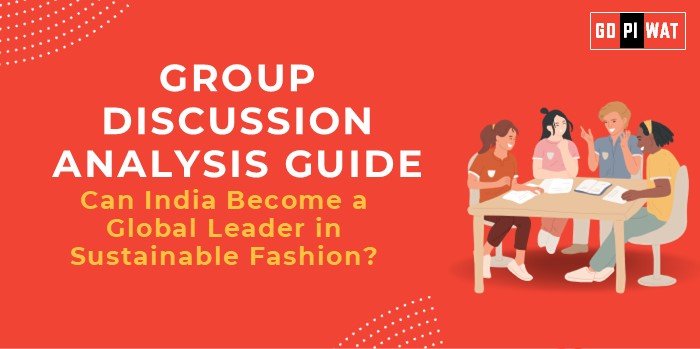📋 Group Discussion (GD) Analysis Guide: Can India Become a Global Leader in Sustainable Fashion?
🌍 Introduction to Sustainable Fashion
Opening Context: “The global fashion industry, valued at over $1.5 trillion, is also one of the most polluting, accounting for 10% of global carbon emissions. India, with its rich textile heritage and emerging sustainable practices, stands at a crossroads to lead this transformation.”
Topic Background: The concept of sustainable fashion focuses on reducing environmental and social impacts associated with clothing production and consumption. In India, this is tied to both traditional craftsmanship and modern innovations.
📊 Quick Facts and Key Statistics
- 🌍 Global Market Share: The sustainable fashion market is expected to grow at a CAGR of 9.1% from 2023 to 2030, driven by consumer awareness and government regulations.
- 📈 India’s Textile Industry: Accounts for 5% of global trade, contributing $120 billion to GDP annually.
- 🌏 Carbon Footprint: The fashion industry globally emits 1.2 billion tons of CO₂ yearly; India’s share is rising due to fast fashion.
- 💧 Water Usage: 10,000 liters of water are used to produce 1 kg of cotton fabric; sustainable practices can cut this by 50%.
🤝 Stakeholders and Their Roles
- 🏛️ Government: Enacts regulations, incentivizes green technology, and supports traditional crafts.
- 🏢 Private Sector: Innovates in circular fashion, promotes eco-friendly products, and ensures supply chain transparency.
- 🛒 Consumers: Drives demand for ethical products and practices.
- 🌐 NGOs/International Organizations: Provides frameworks like the UN’s Fashion Industry Charter for Climate Action.
🏆 Achievements and Challenges
✨ Achievements
- 🌿 Innovative Practices: Companies like Fabindia and Arvind Ltd are leading with sustainable production methods.
- 📜 Policy Support: Government initiatives like Project SU.RE (Sustainable Resolution) involve industry leaders.
- 🌍 Global Recognition: Indian khadi and handlooms gain traction in global sustainable fashion markets.
⚠️ Challenges
- 💰 Cost: Sustainable products are often more expensive, limiting market reach.
- 🏗️ Infrastructure: Lack of scalable recycling technologies and facilities.
- 🔍 Consumer Awareness: Low awareness about the environmental impact of fast fashion.
🌏 Global Comparisons
- 🇸🇪 Success: Scandinavian countries lead in circular fashion initiatives.
- 🇧🇩 Challenges: Bangladesh, like India, struggles with scaling sustainability in its large textile sector.
📚 Case Studies
- 🌾 Kerala’s Cotton Initiative: Introduced low-water cotton farming to reduce resource usage.
- 🧵 Rajasthan’s Handloom Revival: Empowered artisans with tech-driven sustainability.
🗣️ Structured Arguments for Discussion
- ✅ Supporting Stance: “India’s traditional handlooms, supported by innovative eco-friendly practices, position the nation to lead the sustainable fashion movement.”
- ❌ Opposing Stance: “High costs and limited scalability of sustainable practices challenge India’s global leadership ambitions.”
- ⚖️ Balanced Perspective: “While India has unique advantages, it needs significant investment in technology and education to become a leader.”
🎯 Effective Discussion Approaches
- 📊 Opening Approaches:
- 🔢 Start with impactful data: “Fashion contributes to 10% of global emissions; India’s textile industry must evolve sustainably.”
- 🌍 Use a comparative lens: “While Scandinavia leads in sustainability, India’s cultural heritage provides unique opportunities.”
- 🔄 Counter-Argument Handling:
- Acknowledge economic challenges but highlight long-term savings.
- Address scalability issues with international collaboration examples.
🔍 Strategic Analysis: SWOT
- 💪 Strengths: Rich heritage, skilled workforce, growing eco-conscious market.
- 🤔 Weaknesses: High costs, limited infrastructure.
- 🚀 Opportunities: Export potential, government incentives, global partnerships.
- ⚠️ Threats: Fast fashion growth, competitive global market.
🎓 Connecting with B-School Applications
- 🌱 Real-World Applications: Discuss potential in sustainable supply chain management and innovative business models.
- 📝 Sample Interview Questions:
- 💬 “How can India scale its sustainable fashion practices?”
- 💬 “What role do traditional crafts play in modern sustainability?”
- 💡 Insights for Students:
- 📈 Explore sustainability in global markets.
- 📚 Analyze case studies of fashion brands integrating circular economies.


